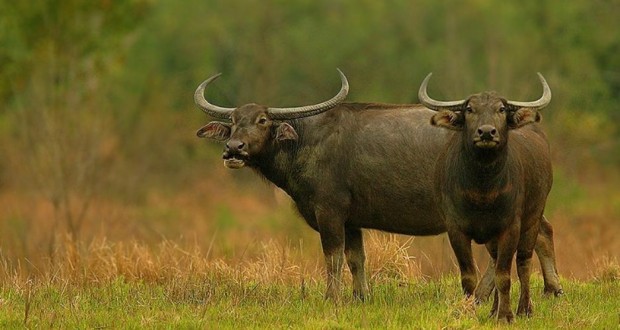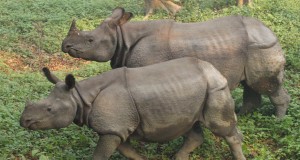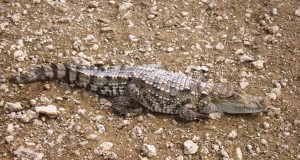WEST BENGAL: Stretching from the Himalaya to the Bay of Bengal, the narrow strip forming West Bengal includes a range of climates and diversity of habitat. Sharing a language, history and culture with Bangladesh, Bengal is both tradition-bound and in part a symbol of India’s progres with industry and booming agriculture.
Ballarpur Sanctuary
Established in 1977 in the grounds of Rabindranath Tagore’s university at Santiniketan, this sanctuary of only 0.75 sq mile (2 sq km) area holds captive blackbuck. Best time to visit: Nov. — Feb. Accommodation: A tourist lodge at Santiniketan Permission: Ballarpur Wildlife Sanctuary, PO Santiniketan, Dist: Birbhum, W. Bengal. Nearest town & Rail: Bolpur (1 mile/3 km) Air: Dum Dum Calcutta (72 miles/115 km)
Buxa Tiger Reserve
This area came under Project Tiger during the winter of 1982/83. Of a total area of 288 sq miles (745 sq km), 121 sq miles (313 sq km) form the core area. The reserve forms a vital linking corridor for elephants migrating between the forests of Bhutan to the north and the Manas Tiger Reserve in Assam to the east. The eastern boundary is the Sankosh River which in turn forms the western boundary of Manas. Much of the reserve was worked in the recent past and the forest has taken over from the natural reedlands. Much of the forest is sal. The range of animals is large and includes, apart from tiger and elephant, gaur, sambar, muntjac, leopard, leopard cat and sloth bear. Mahseer can still be sought in the Rydak river. Best time to visit: Nov. — Apr. Accommodation: forest resthouses Permission: Field Director, Buxa Tiger Reserve. Nearest town & Rail: Alipur Duar Air: Cooch Bihar
migrating between the forests of Bhutan to the north and the Manas Tiger Reserve in Assam to the east. The eastern boundary is the Sankosh River which in turn forms the western boundary of Manas. Much of the reserve was worked in the recent past and the forest has taken over from the natural reedlands. Much of the forest is sal. The range of animals is large and includes, apart from tiger and elephant, gaur, sambar, muntjac, leopard, leopard cat and sloth bear. Mahseer can still be sought in the Rydak river. Best time to visit: Nov. — Apr. Accommodation: forest resthouses Permission: Field Director, Buxa Tiger Reserve. Nearest town & Rail: Alipur Duar Air: Cooch Bihar
Haliday Sanctuary
Established in 1976, this small pocket of mangrove forest in the Hoogly delta is the nesting area of sea turtles and saltwater estuarine crocodiles. Best time to visit: Oct. — Mar. Accommodation: none Permission: DFO, 24 Parganas Division, 35 Gopal Nagar Rd, Calcutta 27 Nearest town: Namkhana (38 miles/60 km) Rail: Diamond Harbour (56 miles/90 km) Air: Dum Dum (110 miles/180 km)
Jalpara Sanctuary
Established in 1943 to protect the rhinoceros of which there are now about 50 in the sanctuary. Lying at the foot of the Bhutan hills, the sanctuary covers only 44 sq miles (115 sq km) and is bisected by the river Torsa.  The sandy river banks have extensive belts of tall grass. The forest is rich, mixed deciduous and riding elephants is the only way to move through the area. Apart from rhino, there are tiger, gaur, leopard, sambar, muntjac, hog deer and elephant. Among the rich avifauna, the Bengal florican is typical of the area. Best time to visit: Nov. — Apr. Accommodation: forest lodge with board and forest resthouses, WBTDC Madarihat Tourist Lodge. Permission: DEO, Wildlife Division II, PO Jalpaiguri, West Bengal Nearest town & Rail: Madari Hat (1 mile) Air: Cooch Bihar (28 miles/45 km)
The sandy river banks have extensive belts of tall grass. The forest is rich, mixed deciduous and riding elephants is the only way to move through the area. Apart from rhino, there are tiger, gaur, leopard, sambar, muntjac, hog deer and elephant. Among the rich avifauna, the Bengal florican is typical of the area. Best time to visit: Nov. — Apr. Accommodation: forest lodge with board and forest resthouses, WBTDC Madarihat Tourist Lodge. Permission: DEO, Wildlife Division II, PO Jalpaiguri, West Bengal Nearest town & Rail: Madari Hat (1 mile) Air: Cooch Bihar (28 miles/45 km)
Lothian Island Sanctuary
Established in 1976, this 14 sq miles (37 sq km) area of mangrove is the nesting area of numerous sea turtles. Best time to visit: Oct. — Mar. Accommodation: none Permission: DFO, 24 Parganas Division, 35 Gopal Nagar Rd, Calcutta 27 Nearest town: Namkhana (19 miles/30 km) Rail: Diamond Harbour (40 miles/64 km) Air: Dum Dum (Calcutta) Mahanada Sanctuary. Established in 1976 it consists of 50 sq miles (130 sq km) of mixed forest on the foothills of the eastern Himalaya. The height ranges from 500 to 4266 feet (150 to 1300 meters) above m.s.l. and this is reflected in the range of animals seen. A few swamp deer on the lower grasslands, the occasional elephant, leopard, and, in the higher forest, serow. Best time to visit: Nov. — Mar. Accommodation: 2 resthouses Permission: DFO, Kurseong Division, Downhill PO, Dist: Darjeeling, West Bengal Nearest town & Rail: Siliguri (5 miles/8 km) Air: Bagdogra (14 miles/20 km)
Gopal Nagar Rd, Calcutta 27 Nearest town: Namkhana (19 miles/30 km) Rail: Diamond Harbour (40 miles/64 km) Air: Dum Dum (Calcutta) Mahanada Sanctuary. Established in 1976 it consists of 50 sq miles (130 sq km) of mixed forest on the foothills of the eastern Himalaya. The height ranges from 500 to 4266 feet (150 to 1300 meters) above m.s.l. and this is reflected in the range of animals seen. A few swamp deer on the lower grasslands, the occasional elephant, leopard, and, in the higher forest, serow. Best time to visit: Nov. — Mar. Accommodation: 2 resthouses Permission: DFO, Kurseong Division, Downhill PO, Dist: Darjeeling, West Bengal Nearest town & Rail: Siliguri (5 miles/8 km) Air: Bagdogra (14 miles/20 km)
Sajnakhali Sanctuary
Established in 1976 and incorporating 140 sq miles (362 sq km) of the Sunderbans. Tiger and fishing cat are the main mammals seen. Also some olive ridley turtles. Best time to visit: July — Sept. Accommodation: tourist bungalow Permission: Field Director, Sunderbans Tiger Reserve, 24 Parganas, PO Canning, West Bengal Nearest town: Gosaba (14 miles/20 km) Rail: Canning (48 miles/76 km) Air: Dum Dum (Calcultta) (85 miles)
Sunderbans National Park and Tiger Reserve.
Up to independence, a vast region of mangrove swamp, forested islands and small rivers covering over 6526 sq mile (16,907 sq km) stretched from the Hoogly in the west to the Tetulia river in the east. The Reserve is 998 sq miles (2585 sq km), of which 513 sq miles (1330 sq km) is national park and forms the core. Most of the area is estuarine mangrove forest and swamp supporting an ecosystem specially adapted to high salinity. The park holds more tigers than any other tiger reserve. In the area to the east under Bangladesh, slightly more than 400 tigers were recorded in its 2600 sq miles (6736 sq km) during the mid 1980s. Project Tiger has also launched a program to conserve the ridley sea turtle. A motor-launch is available with the park authority. Best time to visit: Dec. — Feb. Accommodation: Forest lodge at Sajnakhali Permission: Field Director, Sunderbans Tiger Reserve, PO Canning, Dist. 24 Parganas, W. Bengal. Nearest town: Gosaba (31 miles/50 km) Rail: Canning (66 miles/105 km) Air: Dum Dum (Calcutta) (104 miles) Other santuaries in Bengal include Bethvadahari (Nadia dist.), Chapramari (Jalpaiguri dist.), Gorumara (Jalpaiguri dist.)., Narendrapur (24 Parganas), Parmadan (Nadia dist.), Ramnabagan (Burdwan dist.), and Senchal (Darjeeling dist.).
east. The Reserve is 998 sq miles (2585 sq km), of which 513 sq miles (1330 sq km) is national park and forms the core. Most of the area is estuarine mangrove forest and swamp supporting an ecosystem specially adapted to high salinity. The park holds more tigers than any other tiger reserve. In the area to the east under Bangladesh, slightly more than 400 tigers were recorded in its 2600 sq miles (6736 sq km) during the mid 1980s. Project Tiger has also launched a program to conserve the ridley sea turtle. A motor-launch is available with the park authority. Best time to visit: Dec. — Feb. Accommodation: Forest lodge at Sajnakhali Permission: Field Director, Sunderbans Tiger Reserve, PO Canning, Dist. 24 Parganas, W. Bengal. Nearest town: Gosaba (31 miles/50 km) Rail: Canning (66 miles/105 km) Air: Dum Dum (Calcutta) (104 miles) Other santuaries in Bengal include Bethvadahari (Nadia dist.), Chapramari (Jalpaiguri dist.), Gorumara (Jalpaiguri dist.)., Narendrapur (24 Parganas), Parmadan (Nadia dist.), Ramnabagan (Burdwan dist.), and Senchal (Darjeeling dist.).





